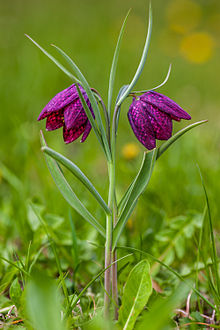Fritillaria meleagris
| Fritillaria meleagris | |
|---|---|
 |
|
| Scientific classification | |
| Kingdom: | Plantae |
| (unranked): | Angiosperms |
| (unranked): | Monocots |
| Order: | Liliales |
| Family: | Liliaceae |
| Genus: | Fritillaria |
| Species: | F. meleagris |
| Binomial name | |
|
Fritillaria meleagris L. |
|
| Synonyms | |
|
Synonymy
|
|
Fritillaria meleagris is a Eurasian species of flowering plant in the lily family. Its common names include snake's head fritillary, snake's head (the original English name), chess flower, frog-cup, guinea-hen flower, guinea flower, leper lily (because its shape resembled the bell once carried by lepers), Lazarus bell, chequered lily, chequered daffodil, drooping tulip or, in northern Europe, simply fritillary.
The name Fritillaria comes from the Latin fritillus meaning dice-box, possibly referring to the chequered pattern on the flowers although this derivation has been disputed. The name meleagris means "spotted like a guineafowl". The common name "snake's head" probably refers to the somewhat snakelike appearance of the nodding flower heads on their long stems. Vita Sackville-West called it "a sinister little flower, in the mournful colour of decay".
The flower has a chequered pattern in shades of purple, or is sometimes pure white. It flowers from March to May and grows between 15–40 cm (6–16 in) in height. The plant has a button-shaped bulb, about 2 cm in diameter, containing poisonous alkaloids. It grows in grasslands in damp soils and river meadows at altitudes up to 800 m (2,625 ft).
Fritillaria meleagris is native to Europe and western Asia but in many places it is an endangered species that is rarely found in the wild but is commonly grown in gardens. In Croatia, the flower is known as kockavica and is associated by some with the country's national symbol. It is the official flower of the Swedish province of Uppland, where it grows in large quantities every spring at the meadows in Kungsängen (Kings meadow), just outside Uppsala, which gives the flower its Swedish name, kungsängslilja (Lily of Kings meadow). It is also found for example in Sandemar Nature Reserve, a nature reserve west of Dalarö in .
In the United Kingdom there is some disagreement amongst botanists as to whether F. meleagris is a native species or a long-established garden escapee. The plant was first described in the 16th century by herbalist John Gerard who had only known of it as a garden plant and it was not recorded in the wild until 1736, which has led some to argue that it must be an escapee. However, the fact that its habitat is usually confined to ancient hay meadows and it does not easily spread to adjoining land, leads others to the conclusion that it is a native species which became isolated from the European population when Britain was cut off from mainland Europe after the last glacial period.Clive Stace (2010) says that it is "doubtfully native".
...
Wikipedia
